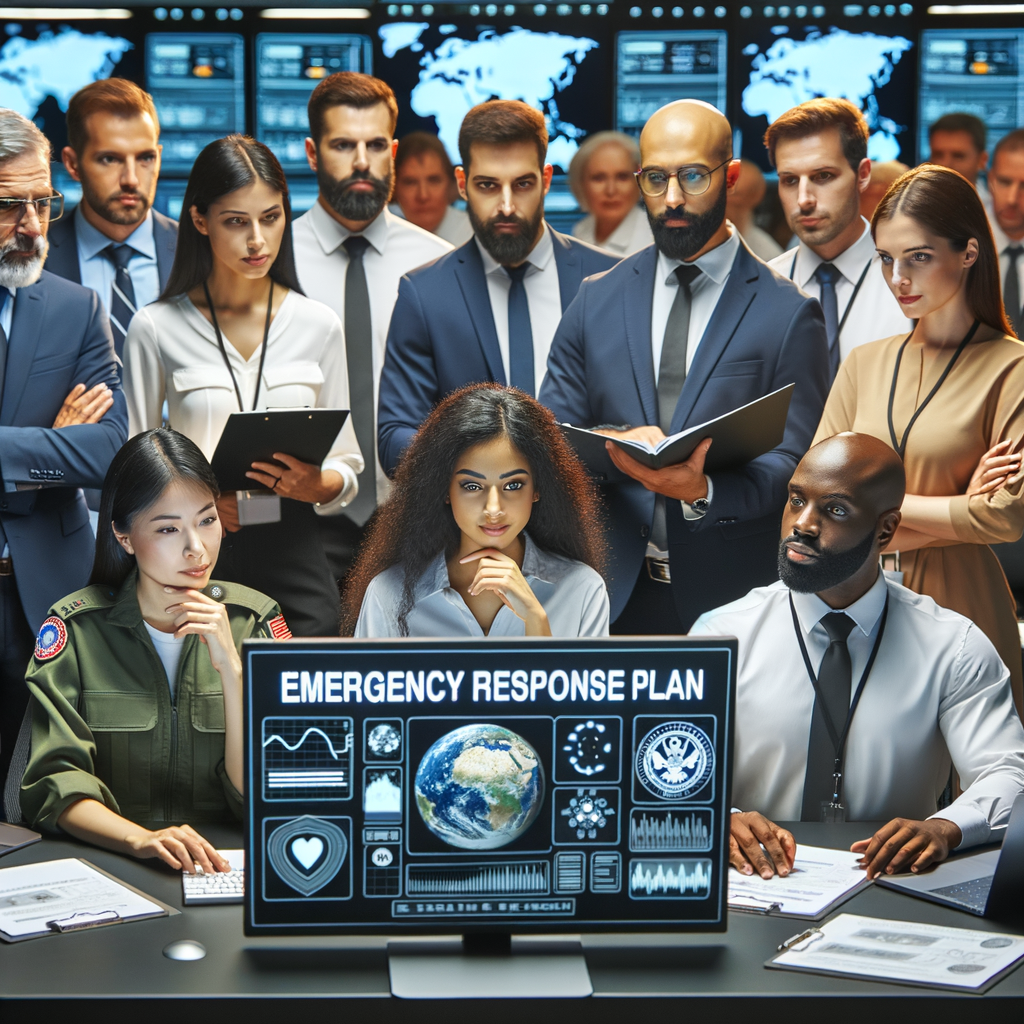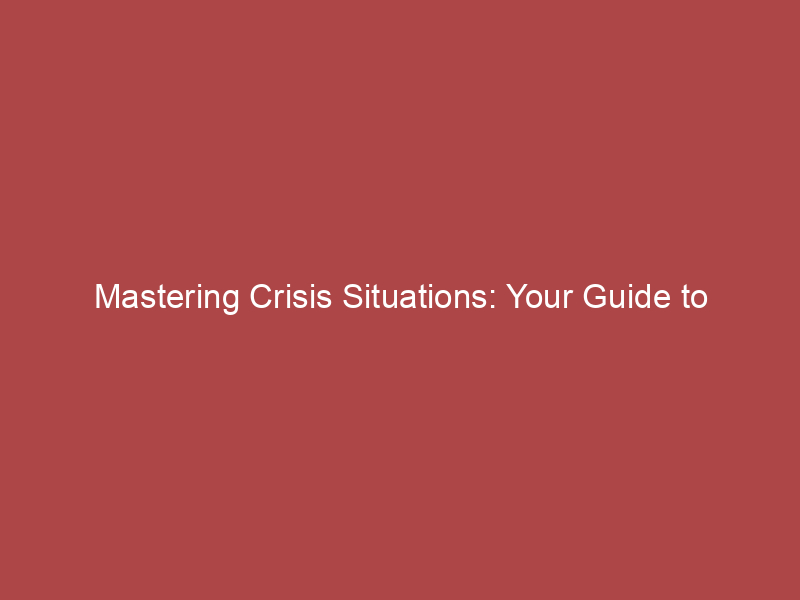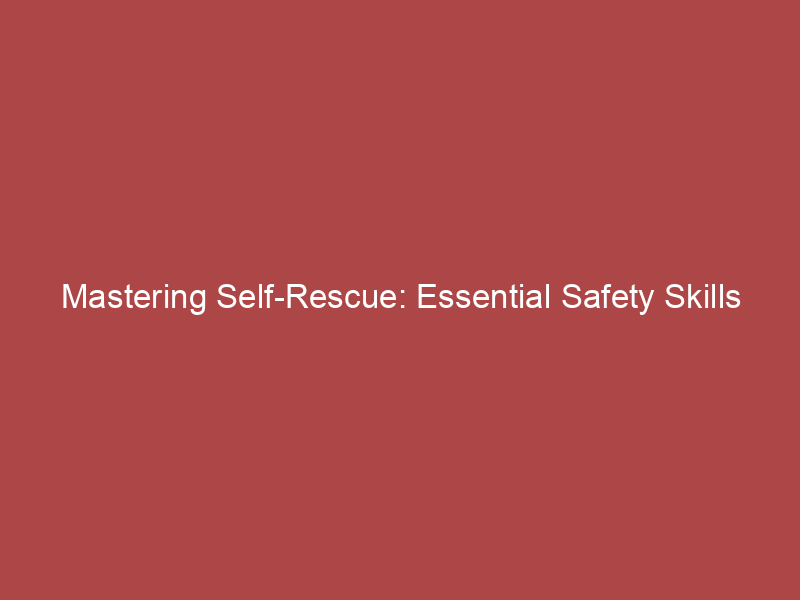
Introduction to Crisis Management
When unexpected situations arise, it’s important to know how to handle them. This is where crisis management comes into play. Crisis management is the process of preparing for and responding to unexpected situations, often emergencies, in a way that minimizes damage and allows the organization to return to normal operations as quickly as possible.
-
- Understanding Crisis Situations
A crisis situation can be any event that threatens the stability of an organization or community. This could include natural disasters like earthquakes or floods, man-made disasters like fires or chemical spills, or even social crises like public health emergencies or political unrest. The key to understanding crisis situations is recognizing that they are unpredictable, often come without warning, and can have severe impacts if not properly managed.
-
- Importance of Effective Emergency Response
When a crisis situation occurs, the initial response is crucial. An effective emergency response can help to minimize damage, protect lives, and speed up recovery. According to a study by the Federal Emergency Management Agency (FEMA), every dollar spent on emergency preparedness can save seven dollars in recovery costs. This highlights the importance of having a well-planned and practiced emergency response.
In the following sections, we will delve deeper into the components of crisis management, including emergency response planning, preparedness, handling crisis situations, and training. We will also discuss various strategies that can be employed during a crisis. By the end of this article, you will have a better understanding of crisis management and how to master crisis situations.
Emergency Response Plan
An Emergency Response Plan is a crucial part of any organization’s strategy to ensure safety and continuity in the face of unexpected events. Let’s delve into the key components of an effective plan.
Components of an Effective Emergency Response Plan
There are four main components that make up an effective Emergency Response Plan. Each of these components plays a vital role in ensuring that your organization is well-prepared to handle any crisis situation.
-
- Identification of Potential Risks
Identifying potential risks is the first step in creating an effective emergency response plan. This involves assessing your organization’s vulnerabilities and determining what types of emergencies are most likely to occur. This could range from natural disasters like earthquakes and floods, to human-caused incidents like fires or cyber-attacks.
-
- Development of Emergency Procedures
Once potential risks have been identified, the next step is to develop procedures to respond to these emergencies. This includes steps to ensure the safety of employees, minimize damage, and restore normal operations as quickly as possible. These procedures should be clear, concise, and easy to follow even under stressful conditions.
-
- Allocation of Roles and Responsibilities
Every member of your organization should know their role in an emergency. This includes who is responsible for what actions, who will make decisions, and who will communicate with the public and the media. Clear roles and responsibilities ensure a coordinated and effective response.
-
- Training and Simulation Exercises
Training and simulation exercises are crucial for ensuring that everyone knows what to do in an emergency. These exercises allow team members to practice their roles and responsibilities, test the effectiveness of the plan, and identify areas for improvement. Regular training also helps to keep the plan fresh in everyone’s mind.
In conclusion, an effective Emergency Response Plan involves identifying potential risks, developing emergency procedures, allocating roles and responsibilities, and conducting regular training and simulation exercises. By focusing on these four components, your organization can be better prepared to handle any crisis situation.
Implementing the Emergency Response Plan
Once you have designed your Emergency Response Plan, the next step is to implement it. This involves two key steps: Communicating the Plan and Regular Review and Update.
-
Communicating the Plan
Clear communication is essential for the successful implementation of any plan, especially an Emergency Response Plan. This involves ensuring that everyone in your organization understands the plan and knows their roles and responsibilities. Here’s how you can effectively communicate your plan:
- Meetings: Hold regular meetings to discuss the plan. Use simple language and visual aids to explain the procedures.
- Training: Conduct training sessions to help your team understand the plan better. Use real-life examples and case studies to make the training more effective.
- Written Materials: Distribute written materials such as manuals and guides. These can serve as a handy reference for your team.
-
Regular Review and Update
Emergency Response Plans are not static. They need to be regularly reviewed and updated to ensure they remain effective. Here’s how you can do this:
- Regular Reviews: Schedule regular reviews of the plan. Look for any changes in your organization or the environment that might affect the plan.
- Feedback: Encourage feedback from your team. They might have valuable insights that can improve the plan.
- Updates: Make necessary updates based on the reviews and feedback. Communicate these updates to your team promptly.
In conclusion, implementing an Emergency Response Plan involves clear communication and regular reviews and updates. By following these steps, you can ensure that your plan remains effective and your organization is prepared for any emergency.
Emergency Preparedness
In the face of potential crises, it is crucial to be prepared. Emergency preparedness is not just about having a plan in place, but also about fostering a culture of readiness within your organization. Let’s delve into the key aspects of building this culture.
Building a Culture of Preparedness
Creating a culture of preparedness involves two main steps: raising employee awareness and conducting regular drills and simulations.
-
- Employee Awareness and Training
Ensuring that every member of your team is aware of the potential risks and knows how to respond is the first step towards preparedness. This can be achieved through regular training sessions. For example, a study by the National Safety Council showed that organizations that conducted regular safety training had a 42% lower incident rate.
-
- Regular Drills and Simulations
Practice makes perfect. Regular drills and simulations help employees understand how to apply their training in real-life situations. According to the Occupational Safety and Health Administration, companies that conduct regular drills have a significantly faster response time during actual emergencies.
Building a culture of preparedness is a continuous process. It involves educating employees about potential risks and providing them with the tools and training they need to respond effectively. By doing so, you can ensure that your organization is ready to handle any crisis that may arise.
Emergency Preparedness Resources
When it comes to emergency preparedness, there are two key resources that can help you and your team respond effectively and efficiently. These are the Emergency Response Guide and the Emergency Action Plan. Let’s take a closer look at each of these resources.
- Emergency Response Guide
The Emergency Response Guide is like a roadmap for handling emergencies. It provides step-by-step instructions on what to do, who to call, and how to stay safe during a crisis. This guide is usually customized to fit the specific needs and circumstances of your organization. It’s a great tool to have because it takes the guesswork out of emergency response.
For example, a school’s Emergency Response Guide might include procedures for lockdowns, fire drills, and evacuation routes. A manufacturing plant, on the other hand, might have procedures for chemical spills, machinery malfunctions, and worker injuries.
- Emergency Action Plan
The Emergency Action Plan, on the other hand, is a detailed plan that outlines the actions employees should take to ensure their safety during a crisis. It includes information such as emergency contact numbers, evacuation procedures, and locations of emergency supplies.
Imagine you’re at work and the fire alarm goes off. What do you do? Where do you go? An Emergency Action Plan answers these questions. It tells you where the nearest exit is, where to gather outside, and who to report to once you’re safe. It’s like a game plan for emergencies.
Both the Emergency Response Guide and the Emergency Action Plan are essential tools in emergency preparedness. They provide clear, easy-to-follow instructions that can save lives and prevent injuries during a crisis. So, make sure your organization has these resources, and that everyone knows how to use them.
Handling Crisis Situations
When a crisis hits, it’s crucial to handle it effectively to minimize the impact. This section will guide you through the initial steps to take in response to a crisis situation.
Initial Response to Crisis
The initial response to a crisis is a critical phase that can determine the course of events. It involves two main steps:
-
- Assessment of the Situation
As soon as a crisis occurs, it’s important to assess the situation immediately. This involves understanding the nature of the crisis, its potential impact, and the resources available to address it. For example, in a fire incident, the assessment would include the size of the fire, the potential for it to spread, and the availability of firefighting resources.
-
- Implementation of Emergency Procedures
Once the situation has been assessed, the next step is to implement emergency procedures. These are predefined actions designed to address the crisis effectively. In the fire incident example, this could include activating the fire alarm, evacuating the building, and contacting the fire department.
These initial steps are crucial in managing a crisis. They provide a structured approach to dealing with the unexpected, helping to reduce panic and confusion. Remember, the goal is to minimize harm and restore normalcy as quickly as possible.
Long-term Management of Crisis Situations
Once the immediate crisis has been addressed, it’s crucial to shift focus to the long-term management of the situation. This involves two main steps: continued monitoring and assessment, and adjustment of response as necessary.
- Continued Monitoring and Assessment
Continued monitoring and assessment is a critical aspect of long-term crisis management. It involves keeping a close eye on the situation to identify any changes or new developments. This ongoing vigilance allows organizations to stay ahead of the situation and make informed decisions.
For example, during a health crisis like a flu outbreak in a school, the school administration would need to continually monitor the health of the students and staff. They would need to keep track of new cases, recoveries, and any changes in the severity of the illness. This information would be crucial in guiding their ongoing response to the crisis.
- Adjustment of Response as Necessary
The second key aspect of long-term crisis management is the adjustment of response as necessary. No crisis situation is static; things change and evolve over time. As such, the response to the crisis must also be flexible and adaptable.
Continuing with our school flu outbreak example, if the administration finds that the number of cases is not decreasing despite their efforts, they may need to adjust their response. This could involve implementing stricter health measures, such as mandatory mask-wearing or temporary school closures.
Long-term management of crisis situations requires a proactive and adaptable approach. By continually monitoring the situation and adjusting the response as necessary, organizations can effectively navigate through crises and minimize their impact.
| Key Aspects of Long-term Crisis Management |
|---|
| Continued Monitoring and Assessment |
| Adjustment of Response as Necessary |
Emergency Response Training
Emergency Response Training is a critical aspect of any organization’s safety protocol. It equips employees with the necessary skills and knowledge to respond effectively to emergencies, ensuring the safety of everyone involved. Let’s delve into the benefits of this training.
Benefits of Emergency Response Training
There are numerous benefits of Emergency Response Training, but we will focus on two key advantages: Increased Employee Confidence and Improved Response Time.
-
- Increased Employee Confidence
One of the main benefits of Emergency Response Training is that it boosts employee confidence. When employees are well-trained, they feel more secure and confident in their ability to handle emergency situations. They know what to do, when to do it, and how to do it effectively. This confidence can significantly reduce panic and chaos during emergencies, leading to a more organized and effective response.
-
- Improved Response Time
Another significant benefit of Emergency Response Training is that it improves response time during emergencies. Well-trained employees can quickly identify potential hazards, understand the situation, and take appropriate action promptly. According to a study, organizations with a well-trained emergency response team can reduce their response time by up to 50%. This quick response can often be the difference between a minor incident and a major catastrophe.
Emergency Response Training is not just a formality or a box to tick in an organization’s safety protocol. It is a crucial investment that can save lives, protect property, and ensure the continuity of operations during emergencies. So, if you haven’t already, consider investing in comprehensive Emergency Response Training for your employees today.
Key Elements of Emergency Response Training
Emergency response training is a crucial part of crisis management. It equips individuals with the necessary skills to handle emergencies effectively. Two key elements of this training are practical exercises and case study analysis. Let’s delve into these components in detail.
-
- Practical Exercises
Practical exercises are an essential part of emergency response training. They provide hands-on experience, allowing trainees to apply the theoretical knowledge they’ve gained. These exercises simulate real-life emergency scenarios, enabling individuals to practice their response in a controlled environment.
For instance, a practical exercise might involve a simulated fire drill. Trainees would need to evacuate a building safely and quickly, following the correct procedures. This type of practical experience can be invaluable in a real emergency, helping to reduce panic and ensure a swift, effective response.
-
- Case Study Analysis
Case study analysis is another key element of emergency response training. It involves examining past emergencies to learn from them. Trainees can study what worked well, what didn’t, and how they can improve their response in the future.
For example, a case study might focus on a natural disaster, like a hurricane or earthquake. Trainees would analyze the response to the disaster, looking at factors such as evacuation procedures, communication strategies, and resource allocation. This analysis can provide valuable insights, helping trainees to understand the complexities of emergency response and prepare for similar situations.
Practical exercises and case study analysis are vital components of emergency response training. They provide a mix of hands-on experience and theoretical learning, helping to prepare individuals for a wide range of emergency situations.
Crisis Management Strategies
In the world of crisis management, there are two main types of strategies: proactive and reactive. Understanding the benefits and limitations of each can help you make the best decisions for your organization.
Proactive vs Reactive Strategies
Proactive strategies are actions taken before a crisis occurs. They are designed to prevent or mitigate the impact of a potential crisis. On the other hand, reactive strategies are responses to a crisis after it has happened. Let’s delve deeper into these strategies.
-
- Benefits of Proactive Strategies
Proactive strategies offer several advantages. First, they allow you to anticipate potential crises and prepare for them. This can reduce the impact of a crisis when it occurs. Second, proactive strategies can help maintain a positive public image. By showing that you are prepared and responsible, you can build trust with your stakeholders. Lastly, proactive strategies can save time and resources in the long run. By preventing crises, you can avoid the costly and time-consuming process of managing them.
-
- Limitations of Reactive Strategies
While reactive strategies are necessary in some situations, they also have limitations. One of the main drawbacks is that they can be more costly than proactive strategies. This is because they often involve damage control, which can be expensive. Additionally, reactive strategies can harm your public image. If stakeholders perceive that you were unprepared for a crisis, they may lose trust in your organization. Finally, reactive strategies can be stressful for your team, as they often involve working under pressure and in a state of uncertainty.
Both proactive and reactive strategies have their place in crisis management, being proactive can often prevent crises from occurring in the first place. Therefore, investing in proactive strategies can be a wise decision for many organizations.
Case Studies: Effective Crisis Management Strategies
Let’s delve into two real-life examples that demonstrate effective crisis management strategies. These case studies will provide you with practical insights and lessons that can be applied in various crisis situations.
-
- Case Study 1: The Tylenol Murders (1982)
In 1982, seven people in Chicago died after consuming Tylenol capsules that had been laced with cyanide. This crisis could have spelled the end for Tylenol, but the company’s swift and transparent response saved its reputation.
Johnson & Johnson, the parent company of Tylenol, immediately pulled 31 million bottles of the product from the shelves, equating to a loss of $100 million. They also collaborated with the police and FBI in their investigations, and launched a public relations campaign to inform the public about the situation.
Most importantly, they introduced tamper-proof packaging and offered replacements to customers. This swift and decisive action not only saved the brand but also led to industry-wide changes in product safety standards.
-
- Case Study 2: PepsiCo’s Syringe Scare (1993)
In 1993, a customer in Washington reported finding a syringe in a can of Diet Pepsi. This led to more than 50 similar reports, causing a nationwide panic.
PepsiCo responded by launching a media campaign that included a video showing the canning process to demonstrate that it would be virtually impossible for a foreign object to enter a can unnoticed. They also collaborated with the FDA, who confirmed that the claims were a hoax.
PepsiCo’s quick, transparent, and factual response helped to quell the panic and protect the brand’s reputation.
These case studies illustrate the importance of swift action, transparency, and communication in effective crisis management. They show that even in the face of a potentially devastating crisis, effective strategies can not only mitigate damage but also strengthen a brand’s reputation.
Conclusion: Mastering Crisis Situations
As we wrap up our discussion on crisis management, it’s clear that being prepared and having a solid plan in place is crucial. Let’s summarize the key points and look at the next steps in your journey to master emergency response.
-
- Key Takeaways
Here are the most important points we’ve covered:
-
-
- Understanding crisis management is the first step towards effective emergency response.
- Having a well-structured emergency response plan is vital. It should include details on roles, responsibilities, and procedures to follow during a crisis.
- Preparedness is key. Regular training and drills can help ensure everyone knows what to do in an emergency.
- Handling crisis situations requires calm, decisive action. Clear communication and teamwork are essential.
- Effective crisis management strategies involve assessing risks, planning, training, and reviewing performance after a crisis.
- Next Steps in Your Emergency Response Journey
-
Now that you’ve learned the basics of crisis management, here’s what you can do next:
-
- Review your current emergency response plan. Look for areas that could be improved and make necessary changes.
- Organize regular training sessions for your team. Make sure everyone understands their roles and responsibilities.
- Conduct drills to test your plan and make adjustments as needed.
- After a crisis, always review what happened and how it was handled. Use this information to improve your plan and training.
Remember, mastering crisis situations isn’t something that happens overnight. It takes time, effort, and a commitment to continuous learning and improvement. But with the right approach, you can become proficient in managing emergencies and ensure the safety and well-being of everyone involved.





